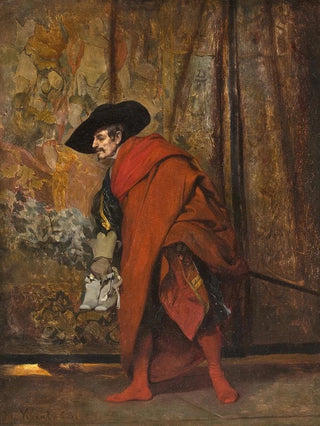Art print | Polonius behind the curtain - Jehan Georges Vibert


View from behind

Frame (optional)
Polonius behind the curtain - Jehan Georges Vibert – Captivating introduction
In the fascinating universe of art history, some works stand out for their ability to capture the collective imagination while evoking timeless stories. "Polonius behind the curtain" by Jehan Georges Vibert is one of those creations that, through its intrigue and depth, invites the viewer to delve into the intricacies of dramaturgy and human emotion. This piece, both theatrical and pictorial, transports us to the heart of a scene where light and shadow play a leading role, revealing the subtleties of human interactions. Vibert, with his mastery of the brush, manages to breathe vibrant life into his characters, making each gaze and gesture charged with meaning.
Style and uniqueness of the work
Vibert's style is characterized by meticulous realism, combined with a romantic sensitivity that transcends the simple frame of the painting. "Polonius behind the curtain" stands out for its skillful use of light, which sculpts the forms and emphasizes the emotions of the depicted figures. The curtain, a symbol of separation and mystery, becomes a central element, creating a palpable tension between the observer and the observed. The details, whether in the textures of clothing or facial expressions, demonstrate scrupulous attention to representation. Vibert, through his approach, manages to establish a dialogue between the viewer and the work, making each contemplation a unique and immersive experience.
The artist and his influence
Jehan Georges Vibert, a French artist of the 19th century, is often associated with the academic tradition while standing out for his originality. His training at the great Parisian art schools allowed him to acquire impeccable technique, but it is his penchant for literary and historical themes that earned him a unique place in the art world. The influence of literature on his work is evident, and "Polonius behind the curtain" is a perfect illustration. Inspired by Shakespeare's play "Hamlet," Vibert does not merely reproduce a scene but explores the underlying emotions.

Matte finish

View from behind

Frame (optional)
Polonius behind the curtain - Jehan Georges Vibert – Captivating introduction
In the fascinating universe of art history, some works stand out for their ability to capture the collective imagination while evoking timeless stories. "Polonius behind the curtain" by Jehan Georges Vibert is one of those creations that, through its intrigue and depth, invites the viewer to delve into the intricacies of dramaturgy and human emotion. This piece, both theatrical and pictorial, transports us to the heart of a scene where light and shadow play a leading role, revealing the subtleties of human interactions. Vibert, with his mastery of the brush, manages to breathe vibrant life into his characters, making each gaze and gesture charged with meaning.
Style and uniqueness of the work
Vibert's style is characterized by meticulous realism, combined with a romantic sensitivity that transcends the simple frame of the painting. "Polonius behind the curtain" stands out for its skillful use of light, which sculpts the forms and emphasizes the emotions of the depicted figures. The curtain, a symbol of separation and mystery, becomes a central element, creating a palpable tension between the observer and the observed. The details, whether in the textures of clothing or facial expressions, demonstrate scrupulous attention to representation. Vibert, through his approach, manages to establish a dialogue between the viewer and the work, making each contemplation a unique and immersive experience.
The artist and his influence
Jehan Georges Vibert, a French artist of the 19th century, is often associated with the academic tradition while standing out for his originality. His training at the great Parisian art schools allowed him to acquire impeccable technique, but it is his penchant for literary and historical themes that earned him a unique place in the art world. The influence of literature on his work is evident, and "Polonius behind the curtain" is a perfect illustration. Inspired by Shakespeare's play "Hamlet," Vibert does not merely reproduce a scene but explores the underlying emotions.






